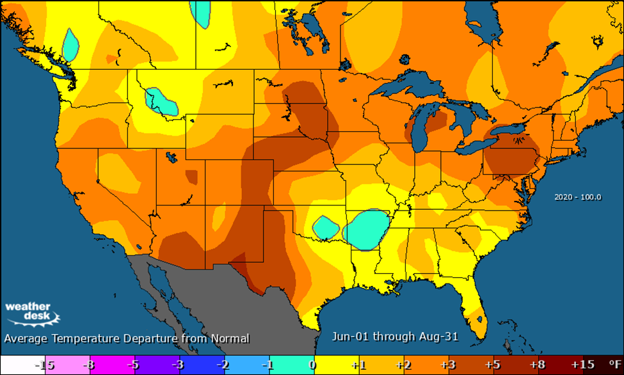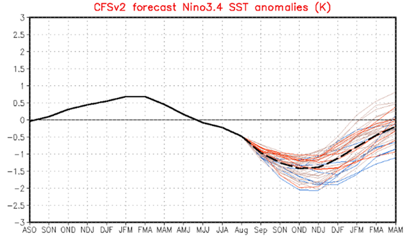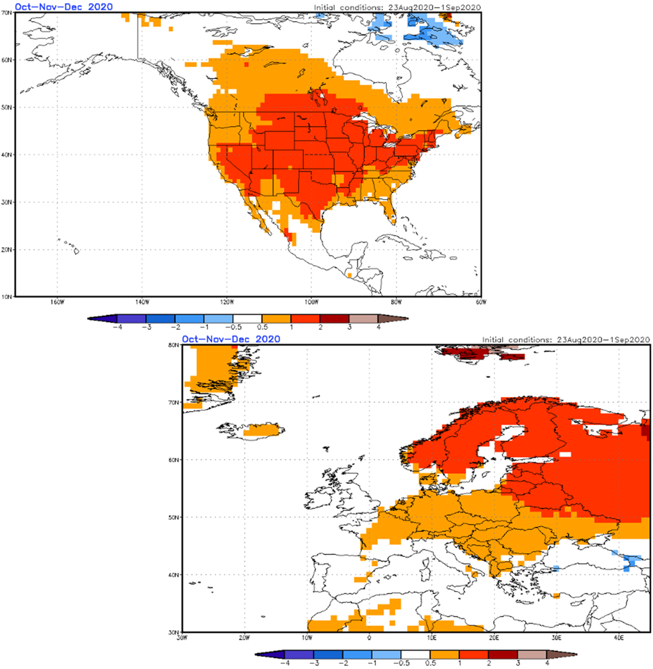This week we review this summer’s record setting heat. All of the top 10 summers on record since 1871 have occurred since 1980, and eight of 10 have happened since 2000. The general consensus is that climate change and urbanization have pushed temperatures upward.
Meteorologist were expecting this summer to be hot with the strong la nina condition going into the summer peak months.

Source: Maxar Weather
We still are still in a strong la nina state, which typically means warmer than normal ultimately wins out. Autumn temps are expected to jump back above normal, after this short cooler period in the 15D forecast. Meteorologist see the short-term weather pattern as a blip in the overall warmer state.

We should note that autumn heat would be bullish if it returns in late September up to first week of October. After that we would consider the heat to be a bearish case as it eats into the Res/Comm demand required for space heating.
The below is the longer-term CFS projection for North American and Europe. Many meteorologists do not put much confidence in the CFS projections, but the Australian model showed a similar forecast.

Fundamentals for week ending Sept 4: Our early view for the upcoming storage report is a +72 Bcf injection for the lower 48. This would take storage levels to 352 Bcf. The industry estimates for this report range between 55-72 according to The Desk.
US natural gas dry production was lower week on week with domestic production averaging 86.3 Bcf/d for the week. Total natural gas demand was much lower than the previous week, with power burns lower by 4.4 Bcf/d week-on-week. Cooler weather across the entire country led to the lower AC load, especially in the West which had been experiencing extreme heat conditions. Hurricane Laura also led to lower burns with many people without power along the coast, and then #Laura bringing rain and cooler temps as it travelled north and eastward.
Canadian imports were lower last week averaging 4.4 Bcf/d. This after a week where higher prices from Marco and Laura brought in more imports. Mexican exports averaged of 6.5 Bcf/d.
Deliveries to LNG facilities averaged 3.0 Bcf/d, down 0.9 Bcf/d week on week. The lower LNG deliveries are primarily from Sabine and Cameron being offline after Hurricane Laura ripped through the Gulf channels. Today, Cameron is still offline, while Sabine has 0.2 Bcf/d nominated to hit the facility.
Expiration and rolls: UNG ETF roll starts on Sept 12th and ends on Sept 17th.
October futures expire on September 28th, and September options expire on September 25th
This email, any information contained herein and any files transmitted with it (collectively, the Material) are the sole property of OTC Global Holdings LP and its affiliates (OTCGH); are confidential, may be legally privileged and are intended solely for the use of the individual or entity to whom they are addressed. Unauthorized disclosure, copying or distribution of the Material, is strictly prohibited and the recipient shall not redistribute the Material in any form to a third party. Please notify the sender immediately by email if you have received this email by mistake, delete this email from your system and destroy any hard copies. OTCGH waives no privilege or confidentiality due to any mistaken transmission of this email.
